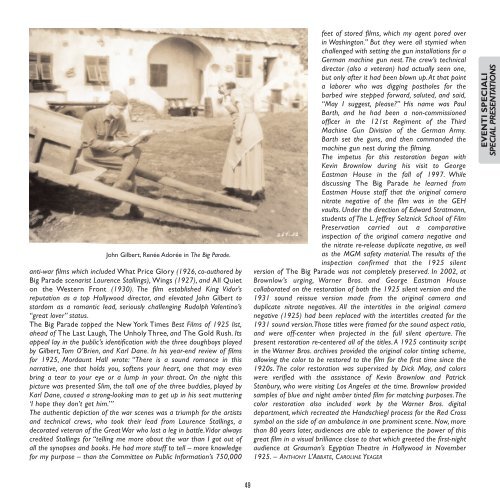Le Giornate del Cinema Muto 2006 Sommario / Contents
Le Giornate del Cinema Muto 2006 Sommario / Contents
Le Giornate del Cinema Muto 2006 Sommario / Contents
Create successful ePaper yourself
Turn your PDF publications into a flip-book with our unique Google optimized e-Paper software.
John Gilbert, Renée Adorée in The Big Parade.<br />
anti-war films which included What Price Glory (1926, co-authored by<br />
Big Parade scenarist Laurence Stallings), Wings (1927), and All Quiet<br />
on the Western Front (1930). The film established King Vidor’s<br />
reputation as a top Hollywood director, and elevated John Gilbert to<br />
stardom as a romantic lead, seriously challenging Rudolph Valentino’s<br />
“great lover” status.<br />
The Big Parade topped the New York Times Best Films of 1925 list,<br />
ahead of The Last Laugh, The Unholy Three, and The Gold Rush. Its<br />
appeal lay in the public’s identification with the three doughboys played<br />
by Gilbert,Tom O’Brien, and Karl Dane. In his year-end review of films<br />
for 1925, Mordaunt Hall wrote: “There is a sound romance in this<br />
narrative, one that holds you, softens your heart, one that may even<br />
bring a tear to your eye or a lump in your throat. On the night this<br />
picture was presented Slim, the tall one of the three buddies, played by<br />
Karl Dane, caused a strong-looking man to get up in his seat muttering<br />
‘I hope they don’t get him.’”<br />
The authentic depiction of the war scenes was a triumph for the artists<br />
and technical crews, who took their lead from Laurence Stallings, a<br />
decorated veteran of the Great War who lost a leg in battle.Vidor always<br />
credited Stallings for “telling me more about the war than I got out of<br />
all the synopses and books. He had more stuff to tell – more knowledge<br />
for my purpose – than the Committee on Public Information’s 750,000<br />
49<br />
feet of stored films, which my agent pored over<br />
in Washington.” But they were all stymied when<br />
challenged with setting the gun installations for a<br />
German machine gun nest. The crew’s technical<br />
director (also a veteran) had actually seen one,<br />
but only after it had been blown up.At that point<br />
a laborer who was digging postholes for the<br />
barbed wire stepped forward, saluted, and said,<br />
“May I suggest, please?” His name was Paul<br />
Barth, and he had been a non-commissioned<br />
officer in the 121st Regiment of the Third<br />
Machine Gun Division of the German Army.<br />
Barth set the guns, and then commanded the<br />
machine gun nest during the filming.<br />
The impetus for this restoration began with<br />
Kevin Brownlow during his visit to George<br />
Eastman House in the fall of 1997. While<br />
discussing The Big Parade he learned from<br />
Eastman House staff that the original camera<br />
nitrate negative of the film was in the GEH<br />
vaults. Under the direction of Edward Stratmann,<br />
students of The L. Jeffrey Selznick School of Film<br />
Preservation carried out a comparative<br />
inspection of the original camera negative and<br />
the nitrate re-release duplicate negative, as well<br />
as the MGM safety material. The results of the<br />
inspection confirmed that the 1925 silent<br />
version of The Big Parade was not completely preserved. In 2002, at<br />
Brownlow’s urging, Warner Bros. and George Eastman House<br />
collaborated on the restoration of both the 1925 silent version and the<br />
1931 sound reissue version made from the original camera and<br />
duplicate nitrate negatives. All the intertitles in the original camera<br />
negative (1925) had been replaced with the intertitles created for the<br />
1931 sound version.Those titles were framed for the sound aspect ratio,<br />
and were off-center when projected in the full silent aperture. The<br />
present restoration re-centered all of the titles. A 1925 continuity script<br />
in the Warner Bros. archives provided the original color tinting scheme,<br />
allowing the color to be restored to the film for the first time since the<br />
1920s. The color restoration was supervised by Dick May, and colors<br />
were verified with the assistance of Kevin Brownlow and Patrick<br />
Stanbury, who were visiting Los Angeles at the time. Brownlow provided<br />
samples of blue and night amber tinted film for matching purposes.The<br />
color restoration also included work by the Warner Bros. digital<br />
department, which recreated the Handschiegl process for the Red Cross<br />
symbol on the side of an ambulance in one prominent scene. Now, more<br />
than 80 years later, audiences are able to experience the power of this<br />
great film in a visual brilliance close to that which greeted the first-night<br />
audience at Grauman’s Egyptian Theatre in Hollywood in November<br />
1925. – ANTHONY L’ABBATE, CAROLINE YEAGER<br />
EVENTI SPECIALI<br />
SPECIAL PRESENTATIONS

















